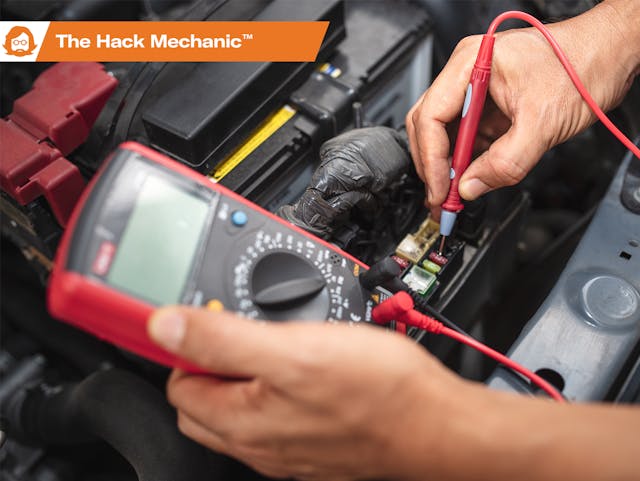Circling the Drain: Sussing out parasitic drains requires a multimeter and creative sleuthing

Joe Boyle writes: I have a 1973 Mercedes 450SL and my wife has an ’89 500SL. The batteries in both cars run down when they’re parked for a week. How do I fix them?
What you’re describing is called a parasitic drain. You can measure the drain with an ammeter (a multimeter configured to measure current), pull fuses until you see it drop, and check the electrical systems on that fuse. This works well on vintage cars, but it’s less effective on modern cars with control modules and dozens of fuses.
I recommend installing a cutoff switch on the negative terminal of the battery. This allows you to easily disconnect the battery while the car is sitting so it won’t run down, but it also facilitates amperage measurement with a multimeter. Most modern meters have a 10-amp fuse, which should be enough for the drain measurement. Clamp one probe on each side of the cutoff switch.

Now, with the engine and all accessories switched off, flip the switch to disconnect the battery and force all current to flow through the multimeter. Note the reading, which may be displayed in amps or milliamps. Ideally, you’ll see less than 50 milliamps. If it’s substantially more, like hundreds of milliamps, you have a non-trivial drain. If it’s single numbers of amps or more, you have a big drain, possibly from a seized electric motor.
Before you begin pulling fuses, disconnect and tape all wires and connectors to the alternator and repeat the test. If the measurement is substantially lower, the alternator may have a bad diode. Next, check to see if any aftermarket systems such as amplifiers have been wired directly to the positive terminal of the battery. If the car has a power antenna, disconnect it. Make sure that interior, trunk, and underhood lights aren’t on and that nothing is plugged into the cigarette lighter.
Your ’73 likely has a small number of fuses, so pull them one at a time and see if the reading changes. If it does, consult the owner’s manual and a wiring diagram to see which systems are on that fuse, and disconnect them one at a time. If that’s not productive, disconnect the battery, unbolt the fuse box, lift it up, and see for yourself what’s actually connected to that fuse, as it’s quite possible that a non-stock system was added.
In the ’89, finding a parasitic drain is more challenging, as it probably has many more fuses, in multiple locations, and systems may have more than one fuse. Start by searching for “battery drain” on a web forum dedicated to your car to see if it unearths a common problem. Be aware that the control modules in modern cars are supposed to go to sleep after the doors are locked, but the process may take between 15 minutes and an hour, so you’ll need to watch to confirm that the amperage reading drops. If it doesn’t, the problem could be that a module isn’t going to sleep, which in turn could be because a door, trunk, or hood sensor isn’t registering closure, or a lock servo is remaining on. A good marque-specific scan tool can pull codes that may identify which module isn’t sleeping and why, but it can still take a lot of sleuthing. And in the end, the answer may still be that this electronics-laden model needs a trickle charger if it’s not driven weekly.

